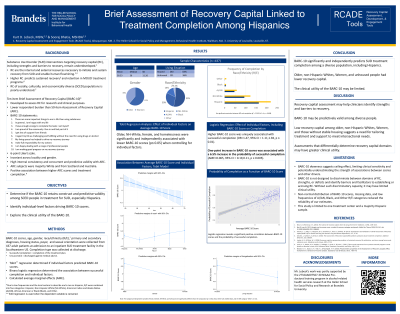Back

(97) Brief Assessment of Recovery Capital Linked to Treatment Completion Among Hispanics
Saturday, April 6, 2024
9:45 AM – 1:15 PM


Kurt D. Lebeck, MSW
Primary Investigator
Kurt D Lebeck, Massachusetts
Sooraj S. Bhatia, MS
Researcher
Sooraj Bhatia, New Mexico
Presenter(s)
Non-presenting author(s)
Background & Introduction: Substance Use Disorder (SUD) interventions targeting recovery capital (RC), including strengths and barriers to recovery, remain underdeveloped. RC includes the internal and external resources necessary to initiate and sustain recovery from SUD. The ten-item Brief Assessment of Recovery Capital (BARC-10) survey was developed to assess RC for research and clinical purposes. The BARC-10 is internally consistent and concurrently valid with the original 50-item Assessment of Recovery Capital but has yet to be tested in a residential treatment setting with a majority Hispanic population. Determining if the BARC-10 is valid among non-majority races and ethnicities may help researchers and clinicians understand the recovery capital of marginalized populations and develop interventions tailored to their unique needs. Prior research demonstrated an association between successful completion and higher BARC-10 scores. We investigated whether the BARC-10 predicted the successful completion of SUD treatment among Hispanic patients and sought to identify individual-level and environmental confounders and drivers of BARC-10 scores.
Methods: BARC-10 scores were collected from 437 adult patients recently entering residential SUD treatment in a medium-sized town in the Southwestern United States. Using logistic regression, we examined if various characteristics, including primary and secondary diagnosis, ethnicity, age, gender, housing status, payer type, sexual orientation, presence of a co-occurring disorder, and BARC-10 scores predicted successful program completion. In addition, using a Tobit regression, we sought to determine if the characteristics predicted higher BARC-10 scores. Due to low frequencies and the local custom to describe one’s race as Hispanic, race and ethnicity were combined into five categories: Hispanic, White/non-Hispanic, American Indian and Alaska Native, African American or Black, and Other.
Results: 51% of the patients identified as Hispanic, 29% White/non-Hispanic, 14% American Indian/Alaskan Native, and 4% Black/African American or Other. 61% identified as men and 39% as women. The median age was 36. Our logistic regression demonstrated a higher BARC-10 score was associated with program completion (OR=1.47, 95% CI = 1.11,1.94, p≤ 0.01). Our Tobit regression demonstrated that being older in age, White/non-Hispanic, female, and homeless were significantly associated with lower BARC-10 scores. Having a primary diagnosis of stimulant use disorder was associated with having a higher BARC-10 score.
Conclusion & Discussion: We conclude that the BARC-10 significantly and independently predicts SUD treatment completion among a majority of Hispanic program participants. This finding may suggest that the construct validity of RC, as operationalized by the BARC-10, is adequate to predict residential treatment completion of Hispanic people in the Southwest. This study is limited to one treatment center and may not generalize to other centers.
References: Cloud, W., & Granfield, R. (2008). Conceptualizing Recovery Capital: Expansion of a Theoretical Construct. Substance Use & Misuse, 43(12–13), 1971–1986. https://doi.org/10.1080/10826080802289762
Groshkova, T., Best, D., & White, W. (2013). The Assessment of Recovery Capital: Properties and psychometrics of a measure of addiction recovery strengths. Drug and Alcohol Review, 32(2), 187–194. https://doi.org/10.1111/j.1465-3362.2012.00489.x
Hennessy, E. A. (2017). Recovery capital: A systematic review of the literature. Addiction Research & Theory, 25(5), 349–360. https://doi.org/10.1080/16066359.2017.1297990
Laudet, A. B., & White, W. L. (2008). Recovery Capital as Prospective Predictor of Sustained Recovery, Life Satisfaction, and Stress Among Former Poly-Substance Users. Substance Use & Misuse, 43(1), 27–54. https://doi.org/10.1080/10826080701681473
Vilsaint, C. L., Kelly, J. F., Bergman, B. G., Groshkova, T., Best, D., & White, W. (2017). Development and validation of a Brief Assessment of Recovery Capital (BARC-10) for alcohol and drug use disorder. Drug and Alcohol Dependence, 177, 71–76. https://doi.org/10.1016/j.drugalcdep.2017.03.022
Methods: BARC-10 scores were collected from 437 adult patients recently entering residential SUD treatment in a medium-sized town in the Southwestern United States. Using logistic regression, we examined if various characteristics, including primary and secondary diagnosis, ethnicity, age, gender, housing status, payer type, sexual orientation, presence of a co-occurring disorder, and BARC-10 scores predicted successful program completion. In addition, using a Tobit regression, we sought to determine if the characteristics predicted higher BARC-10 scores. Due to low frequencies and the local custom to describe one’s race as Hispanic, race and ethnicity were combined into five categories: Hispanic, White/non-Hispanic, American Indian and Alaska Native, African American or Black, and Other.
Results: 51% of the patients identified as Hispanic, 29% White/non-Hispanic, 14% American Indian/Alaskan Native, and 4% Black/African American or Other. 61% identified as men and 39% as women. The median age was 36. Our logistic regression demonstrated a higher BARC-10 score was associated with program completion (OR=1.47, 95% CI = 1.11,1.94, p≤ 0.01). Our Tobit regression demonstrated that being older in age, White/non-Hispanic, female, and homeless were significantly associated with lower BARC-10 scores. Having a primary diagnosis of stimulant use disorder was associated with having a higher BARC-10 score.
Conclusion & Discussion: We conclude that the BARC-10 significantly and independently predicts SUD treatment completion among a majority of Hispanic program participants. This finding may suggest that the construct validity of RC, as operationalized by the BARC-10, is adequate to predict residential treatment completion of Hispanic people in the Southwest. This study is limited to one treatment center and may not generalize to other centers.
References: Cloud, W., & Granfield, R. (2008). Conceptualizing Recovery Capital: Expansion of a Theoretical Construct. Substance Use & Misuse, 43(12–13), 1971–1986. https://doi.org/10.1080/10826080802289762
Groshkova, T., Best, D., & White, W. (2013). The Assessment of Recovery Capital: Properties and psychometrics of a measure of addiction recovery strengths. Drug and Alcohol Review, 32(2), 187–194. https://doi.org/10.1111/j.1465-3362.2012.00489.x
Hennessy, E. A. (2017). Recovery capital: A systematic review of the literature. Addiction Research & Theory, 25(5), 349–360. https://doi.org/10.1080/16066359.2017.1297990
Laudet, A. B., & White, W. L. (2008). Recovery Capital as Prospective Predictor of Sustained Recovery, Life Satisfaction, and Stress Among Former Poly-Substance Users. Substance Use & Misuse, 43(1), 27–54. https://doi.org/10.1080/10826080701681473
Vilsaint, C. L., Kelly, J. F., Bergman, B. G., Groshkova, T., Best, D., & White, W. (2017). Development and validation of a Brief Assessment of Recovery Capital (BARC-10) for alcohol and drug use disorder. Drug and Alcohol Dependence, 177, 71–76. https://doi.org/10.1016/j.drugalcdep.2017.03.022
Learning Objectives:
- Examine the concept of recovery capital and its significance in SUD treatment, including identifying individual strengths and barriers to recovery.
- Assess the construct validity of the BARC-10 and its ability to predict successful SUD treatment outcomes in a diverse population, focusing on a majority Hispanic residential treatment setting.
- Analyze how various demographic factors and co-occurring disorders influence BARC-10 scores and SUD treatment completion, thereby informing the development of tailored interventions for marginalized populations.
